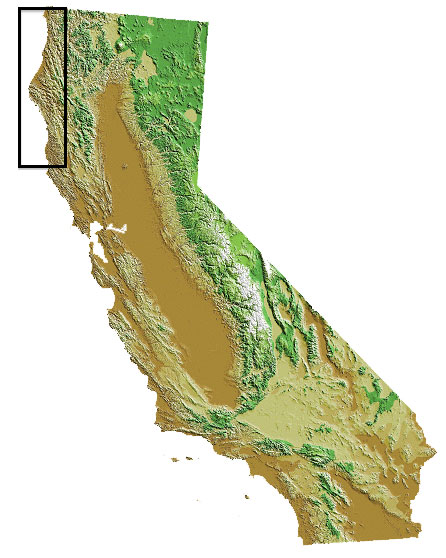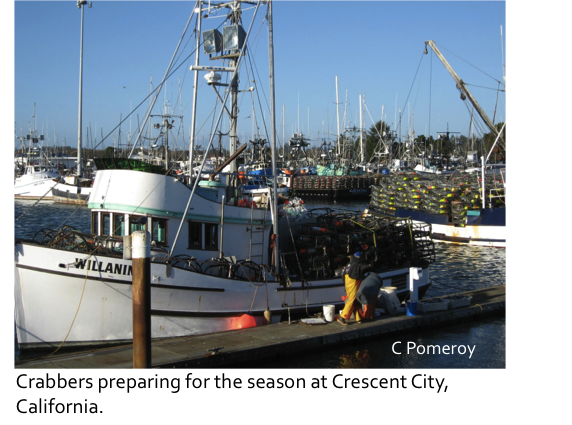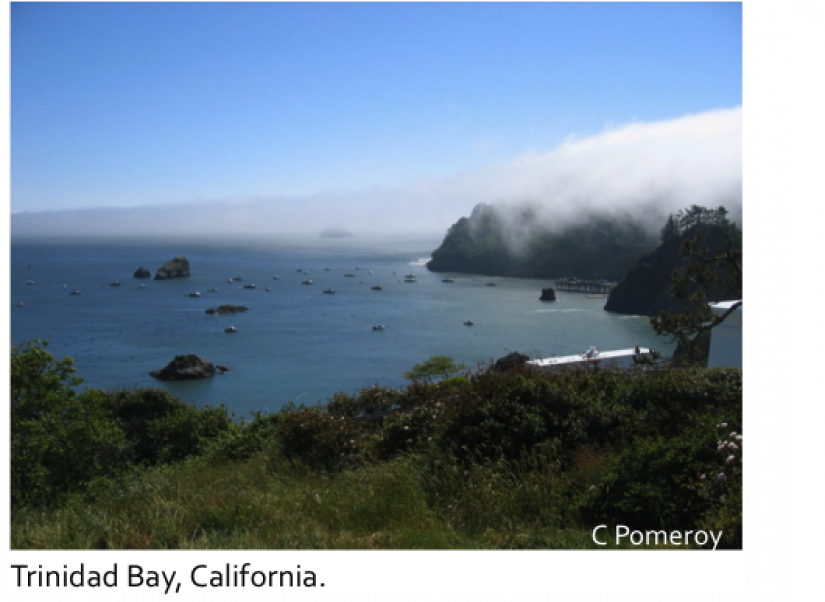Breadcrumb
- Discover California commercial fisheries
- Regions
- North Coast
North Coast

California's North Coast region extends from the Oregon border (Del Norte County) south to Point Arena in Mendocino County. People living in this isolated part of the state have long used fishery resources for livelihood, sport and subsistence. Since at least 2,000 years before European explorers arrived in North America, native peoples have inhabited the North Coast region. Their cultures, communities and livelihoods continue to depend on the region’s diverse native plants and animals, particularly Chinook salmon. Most of the region’s present-day coastal ports were established during the Gold Rush years of the 1850s. Over the years, amid significant changes locally and globally, the region’s fisheries continue to play an important role, economically, socially and culturally.
Fishing communities
This region encompasses three counties with eight primary port-based fishing communities (listed north to south):
| Del Norte County | Humboldt County | Mendocino County |
| Crescent City | Trinidad | Fort Bragg (Noyo Harbor) |
| Eureka | Albion | |
| Fields Landing | Point Area | |
| Shelter Cove |
Types of commercial fisheries
Historically, this region has supported a variety of fisheries, with groundfish, salmon and crab among the most active. However, the mix of fisheries and level of activity in each port and throughout the region varies as a function of changes in species distribution and availability, market demand, regulations, physical infrastructure, buyers and other factors. This region's fisheries and communities have been influenced strongly by stringent salmon regulations to protect stocks and provide for tribal harvests in the rivers, and by complex management of the multi-species, multi-gear groundfish fishery.
In 2013, commercial fishermen landed just under 46 million pounds (nearly 21,000 metric tons) of seafood in this region with an ex-vessel value (amount paid to fishermen) of $82.6 million. The top fisheries (species-gear combinations; in alphabetical order) in terms of pounds landed and/or ex-vessel value included:
See our regional seafood posters and the California commercial landings data (links below) to learn more about the fisheries of this region.
| Ex-vessel value (≥ $3.5 million each) | Pounds landed (≥ 1.2 milion pounds each) |
|---|---|
| Blackcod (sablefish) hook-and-line, trap, trawl | Blackcod hook-and-line, trap, trawl |
| Dungeness crab pot | Dungeness crab pot |
| Groundfish (rockfish, flatfish) hook-and-line, trap, trawl | Groundfish hook-and-line, trap, trawl |
| Pink shrimp trawl | Pink shrimp trawl |
| Red sea urchin dive | Red sea urchin dive |
| Salmon (Chinook or king) troll |
Fisheries seasonality
The chart below shows the times of year when the North Coast region's major commercial fisheries are most active. Other smaller fisheries, while also important, are not shown here. This chart combines all gear types that target the indicated species. Note that fishing activity does not necessarily start at the beginning or stop at the end of a month, and that the timing and types of fisheries may vary from year to year. (See state and federal commercial fishing regulations for current and specific dates.)
Seasonality of selected North Coast California fisheries FROM 2019-2023

The local ocean environment
The North Coast's ocean environment hosts some of the state's most productive fishing grounds. Key features include:
- Bays and estuaries (e.g., Humboldt Bay, the Klamath and Mad River Estuaries)
- Rivers (e.g., the Klamath, Eel, Mad)
- Submarine canyons (e.g., Eel, Delgada, Mattole, Mendocino)
- Nearshore and two primary offshore reefs (Blunts and Saint George)
These features, along with strong coastal upwelling, add to the productivity of the region's marine ecosystem. The area north of Cape Mendocino also is subject to dangerous winter storms, high winds, and summer fog. While these conditions contribute to the region’s high productivity, they also are an important limiting factor for fishing.


The management context
| Fishery | Management Authority | Management Measures | |||||
|---|---|---|---|---|---|---|---|
| State | Federal | Limited entry | Quotas | Time/area closures | Species size/sex rules | Gear restrictions | |
| Blackcod (sablefish) hook-and-line, trap, trawl | ✓ | ✓ | ✓ | ✓ | ✓ | ✓ | ✓ |
| Dungeness crab pot | ✓ | ✓ | ✓ | ✓ | ✓ | ||
| Groundfish hook-and-line, trap, trawl | ✓ | ✓ | ✓ | ✓ | ✓ | ✓ | ✓ |
| Pink shrimp trawl | ✓ | ✓ | ✓ | ||||
| Salmon troll | ✓ | ✓ | ✓ | ✓ | ✓ | ✓ | ✓ |
Note: Management authority and/or measures may vary for a given fishery depending on species and/or gear type.
Information Sources
California Marine Life Protection Act Initiative (CA MLPAI). 2010. MLPAI Regional Profile of the North Coast Study Region (California-Oregon Boarder to Alder Creek), April, 327 pp.
Impact Assessment, Inc. 2010. North Coast Pre-MLPA Community-Based Socioeconomic Characterization and Risk Assessment, Final Report to the Headwaters Fund, December, 204 pp.
Leet, W.S., Dewees, C.M., Klingbeil, R. and E.J. Larson. 2001. California's Living Marine Resources: A Status Report. 4th ed. Sacramento, CA: CDFG, 562 pp.
Pomeroy, C., C. Thomson and M. Stevens. 2010. California's North Coast Fishing Communities: Historical Perspective and Recent Trends. California Sea Grant Technical Report T-072, La Jolla: California Sea Grant, August, 340 pp.
- CDFW Commercial Landings Information
- NMFS Commercial Fisheries Statistics
- Pacific States Marine Fisheries Commission (PSMFC) Pacific Fisheries Information Network (PacFIN)
- North Coast
- North Central Coast
- Santa Barbara Channel
- South Coast